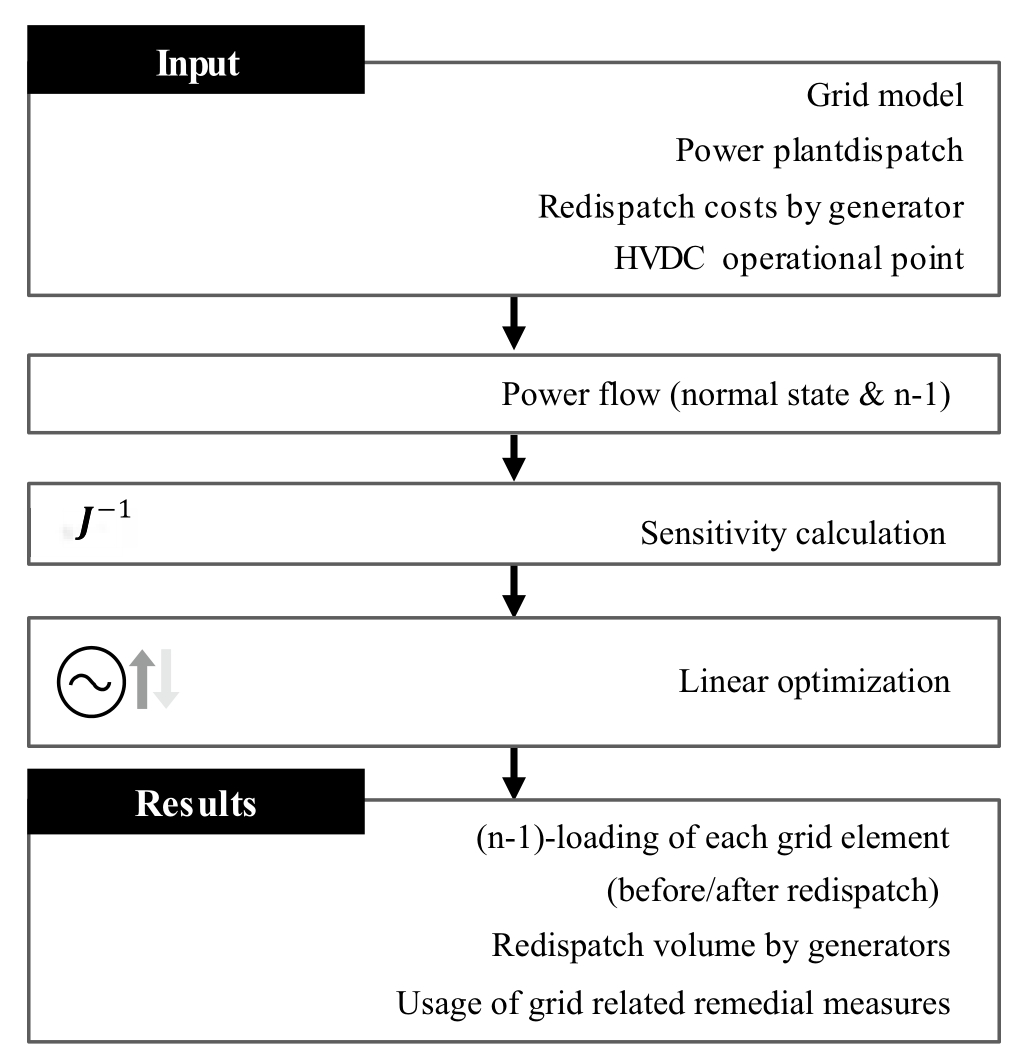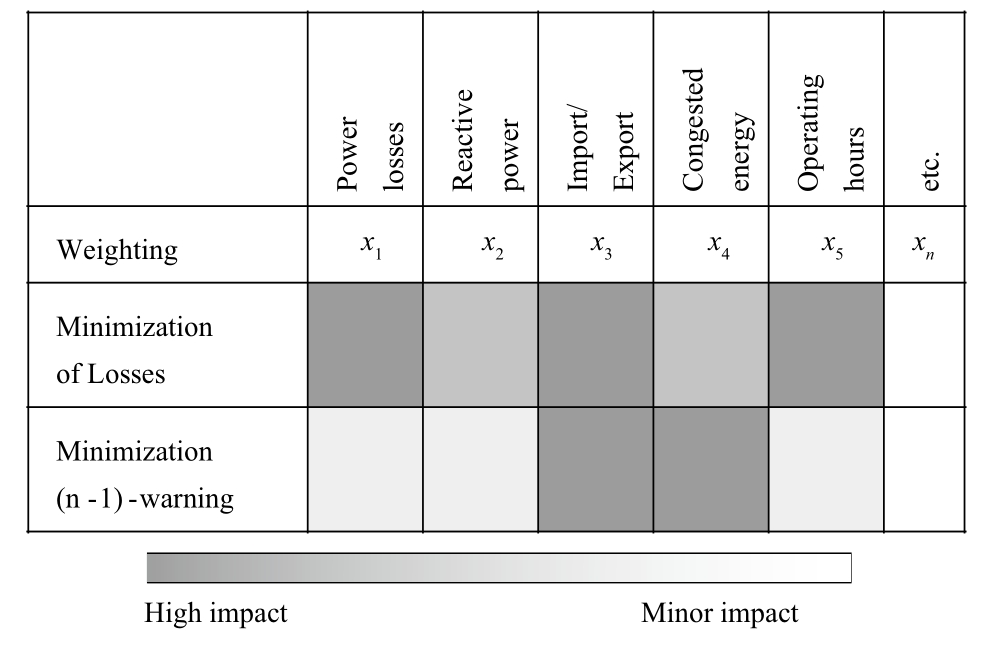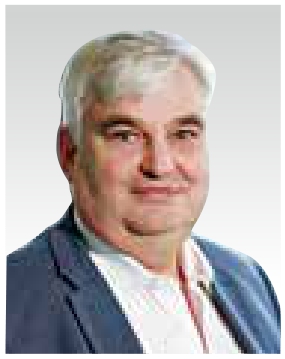1 Introduction
Increased loading of the German transmission grid caused by the regional imbalance of generation and load as well as increasing cross-border flows result in the necessity for grid expansion to maintain grid security.This expansion measures include the realization of HVDC connections parallel to the existing AC grid in Germany.Therefore,a need for reasonable operational concepts of HVDC connections will play an important role in the context of grid security aspects and the planning of remedial measures.In this article,different operational concepts for HVDC connections are evaluated under consideration of grid security aspects.Furthermore,the simulation framework as well as possible evaluation criteria for the evaluation of the different concepts are introduced.
Increased loading of the German transmission grid caused by the regional imbalance of generation and load as well as increasing cross-border flows result in the necessity for grid expansion to maintain grid security.This expansion measures include the realization of HVDC connections parallel to the existing AC grid in Germany.Therefore,a need for reasonable operational concepts of HVDC connections will play an important role in the context of grid security aspects and the planning of remedial measures.In this article,different operational concepts for HVDC connections are evaluated under consideration of grid security aspects.Furthermore,the simulation framework as well as possible evaluation criteria for the evaluation of the different concepts are introduced.
2 Analysis
2.1 Operational Concepts
Different operational concepts vary in their complexity,beginning with the least complex one,the maximum usage of the HVDC connections.In this concept,a maximum power flow on the HVDC connections in southbound direction should be reached.Another concept,which does not necessarily require an optimization,is the voltage angle control.Depending on the voltage angles of the synchronous AC grid,the power flow of the HVDC lines adjusts.
More complex concepts like the minimization of losses or the minimization of (n-1)-warnings as well as (n-1)-indications require an optimization.In the next section,the simulation approach,which also includes the objective function to model the more complex concepts,is introduced.
Different operational concepts vary in their complexity,beginning with the least complex one,the maximum usage of the HVDC connections.In this concept,a maximum power flow on the HVDC connections in southbound direction should be reached.Another concept,which does not necessarily require an optimization,is the voltage angle control.Depending on the voltage angles of the synchronous AC grid,the power flow of the HVDC lines adjusts.
More complex concepts like the minimization of losses or the minimization of (n-1)-warnings as well as (n-1)-indications require an optimization.In the next section,the simulation approach,which also includes the objective function to model the more complex concepts,is introduced.
2.2 Simulation Framework
Optimal operating points of HVDC converters are determined under consideration of operational limits.This is done with the help of an optimization framework,formulated as a so-called security constrained optimal power flow (SCOPF) [1].The input of the optimization framework (see Fig.1) is given by a model of the European transmission grid,a pre-calculated power plant dispatch,redispatch costs of generation units and the HVDC operational limits [2].In this framework,as described before,the different operational concepts of HVDC lines can be analyzed using respective objective functions.
At the beginning of the methodology,a power flow in normal operation as well as in contingency situations((n-1)-state) is simulated followed by the determination of sensitivities from generation units on the respective grid elements.The problem is solved using successive linear optimization.

Fig.1 Overview of Security Constraint Optimal Power Flow
As a result of the optimization,(n-1)-loading of each grid element before and after the usage of remedial measures,redispatch volumes as well as the usage of grid related remedial measures are given.These results can be used to evaluate different operational concepts.
Optimal operating points of HVDC converters are determined under consideration of operational limits.This is done with the help of an optimization framework,formulated as a so-called security constrained optimal power flow (SCOPF) [1].The input of the optimization framework (see Fig.1) is given by a model of the European transmission grid,a pre-calculated power plant dispatch,redispatch costs of generation units and the HVDC operational limits [2].In this framework,as described before,the different operational concepts of HVDC lines can be analyzed using respective objective functions.
At the beginning of the methodology,a power flow in normal operation as well as in contingency situations((n-1)-state) is simulated followed by the determination of sensitivities from generation units on the respective grid elements.The problem is solved using successive linear optimization.

Fig.1 Overview of Security Constraint Optimal Power Flow
As a result of the optimization,(n-1)-loading of each grid element before and after the usage of remedial measures,redispatch volumes as well as the usage of grid related remedial measures are given.These results can be used to evaluate different operational concepts.
2.3 Evaluation Criteria
Due to many stakeholder interests,a straightforward evaluation is complicated.Possible criteria can be distinguished in the categories technical,acceptance,political,transparency and performance aspects.As the focus of this article addresses grid security,the technical aspects will be evaluated.Possible technical criteria are power losses,congested energy and full load hours.Based on these evaluation criteria a simulation is performed for an entire year for each of the operational concepts is conducted.
Due to many stakeholder interests,a straightforward evaluation is complicated.Possible criteria can be distinguished in the categories technical,acceptance,political,transparency and performance aspects.As the focus of this article addresses grid security,the technical aspects will be evaluated.Possible technical criteria are power losses,congested energy and full load hours.Based on these evaluation criteria a simulation is performed for an entire year for each of the operational concepts is conducted.
3 Exemplary Results
The exemplary results in this article are based on two simulations each representing an entire year of operation for a future scenario in 2025.The simulations include the two operational concepts minimization of losses and minimization of (n-1)-warnings.In Fig.2 the results of one exemplary HVDC line in Germany are given by a qualitative load duration curve for each operational concept.

Fig.2 Qualitative HVDC Load Duration Curve
The results show,that the usage of the HVDC line is potentially higher under minimization of (n-1)-warnings compared to the minimization of losses.Under the minimization of losses,there are no situations without usage of the respective HVDC line.Furthermore,a combination of operational concepts could be a reasonable approach to benefit from advantages of both concepts.
In Fig.3 an excerpt of different evaluation criteria for the two operational concepts is given.Focusing on grid security aspects,minimization of (n-1)-warnings results in lower congested energy,which means less overloaded lines before usage of other remedial measures.Nevertheless,in hours without usage of the respective HVDC line to minimize (n-1)-warnings,it can be used to minimize losses for an efficient operation of HVDC lines.

Fig.3 Evaluation Method
The exemplary results in this article are based on two simulations each representing an entire year of operation for a future scenario in 2025.The simulations include the two operational concepts minimization of losses and minimization of (n-1)-warnings.In Fig.2 the results of one exemplary HVDC line in Germany are given by a qualitative load duration curve for each operational concept.

Fig.2 Qualitative HVDC Load Duration Curve
The results show,that the usage of the HVDC line is potentially higher under minimization of (n-1)-warnings compared to the minimization of losses.Under the minimization of losses,there are no situations without usage of the respective HVDC line.Furthermore,a combination of operational concepts could be a reasonable approach to benefit from advantages of both concepts.
In Fig.3 an excerpt of different evaluation criteria for the two operational concepts is given.Focusing on grid security aspects,minimization of (n-1)-warnings results in lower congested energy,which means less overloaded lines before usage of other remedial measures.Nevertheless,in hours without usage of the respective HVDC line to minimize (n-1)-warnings,it can be used to minimize losses for an efficient operation of HVDC lines.

Fig.3 Evaluation Method
4 Conclusion
As operational concepts of HVDC lines become more important in Germany in future,this article focuses on how to determine and evaluate different operational concepts.
In general,the determination of operational concepts highly depends on the definition of reasonable evaluation criteria.Therefore,evaluation criteria have been developed and evaluated using the above methodology.
The evaluation shows that in the context of the overall system,the concepts of reducing losses in combination with minimizing (n-1)-warnings or -indications1 as well as the sole minimization of (n-1)-warnings and -indications are the most reasonable ones.Under grid security aspects best results can be achieved by reducing operational limits and therefore,by the minimization of (n-1)-warnings.
Next to the determination of the operational concepts,further research issues result.One of them would be the question,how these operational concepts can be integrated into day-to-day and real-time transmission grid operation.
References
[1] Monticelli A.et al.Security-Constrained Optimal Power Flow with Post-Contingency Corrective Rescheduling.In:Power Engineering Review,IEEE PER-7.2,1987,p.43-44,URL:http://ieeexplore.org/stamp/stamp.jsp?arnumber=5527553
[2] Eickmann J.et al.:Security-Constraint Optimization Framework for Large-Scale Power Systems Including Post-contingency Remedial Actions and Inter-temporal Constraints,In:Advances in Energy System Optimization :Proceedings of the first International Symposium on Energy System Optimization,Heidelberg,2017,p.47-63



As operational concepts of HVDC lines become more important in Germany in future,this article focuses on how to determine and evaluate different operational concepts.
In general,the determination of operational concepts highly depends on the definition of reasonable evaluation criteria.Therefore,evaluation criteria have been developed and evaluated using the above methodology.
The evaluation shows that in the context of the overall system,the concepts of reducing losses in combination with minimizing (n-1)-warnings or -indications1 as well as the sole minimization of (n-1)-warnings and -indications are the most reasonable ones.Under grid security aspects best results can be achieved by reducing operational limits and therefore,by the minimization of (n-1)-warnings.
Next to the determination of the operational concepts,further research issues result.One of them would be the question,how these operational concepts can be integrated into day-to-day and real-time transmission grid operation.
References
[1] Monticelli A.et al.Security-Constrained Optimal Power Flow with Post-Contingency Corrective Rescheduling.In:Power Engineering Review,IEEE PER-7.2,1987,p.43-44,URL:http://ieeexplore.org/stamp/stamp.jsp?arnumber=5527553
[2] Eickmann J.et al.:Security-Constraint Optimization Framework for Large-Scale Power Systems Including Post-contingency Remedial Actions and Inter-temporal Constraints,In:Advances in Energy System Optimization :Proceedings of the first International Symposium on Energy System Optimization,Heidelberg,2017,p.47-63



Received:9 December 2018/Accepted:14 January 2019/Published:25 April 2019
Annika Klettke
ak@iaew.rwth-aachen.de
Marius Sieberichs
ms@iaew.rwth-aachen.de
Albert Moser
info@iaew.rwth-aachen.de
2096-5117/©2019 Global Energy Interconnection Development and Cooperation Organization.Production and hosting by Elsevier B.V.on behalf of KeAi Communications Co.,Ltd.This is an open access article under the CC BY-NC-ND license (http://creativecommons.org/licenses/by-nc-nd/4.0/).
(n-1)-warnings means limiting the current to 80% of the rated current in (n-1)-situation,(n-1)-indications with a limit of 100%
Biographies
Annika Klettke received bachelor degree at TU Braunschweig University,Braunschweig,2013 and master's degree at RWTH Aachen University,Aachen,2015.She is working at the Institute of Power Systems and Power Economics towards her Ph.D.at RWTH Aachen University.Her research interests include security assessment aspects in the transmission grid.
Marius Sieberichs received bachelor,master and Ph.D.degree at RWTH Aachen University,Aachen,2014,2015 and 2018,respectively.He is working at the Institute of Power Systems and Power Economics as a chief engineer at RWTH Aachen University.His research interests include regulation,transmission and distribution planning.
Albert Moser received the diploma and Ph.D.degree in electrical engineering from RWTH Aachen University,Aachen,Germany,in 1991 and 1995,respectively.Since March 2009,he is head of the Institute of Power Systems and Power Economics (IAEW) at RWTH Aachen University.He was in charge of the business development at European Energy Exchange (EEX) in Leipzig,Germany,and head of the clearing and settlement department of EEX's clearing house.From 1997 to 2000,he was a product developer for TSO applications with Siemens AG in Nuremberg,Germany,and Minneapolis,MN.
(Editor Zhou Zhou)
